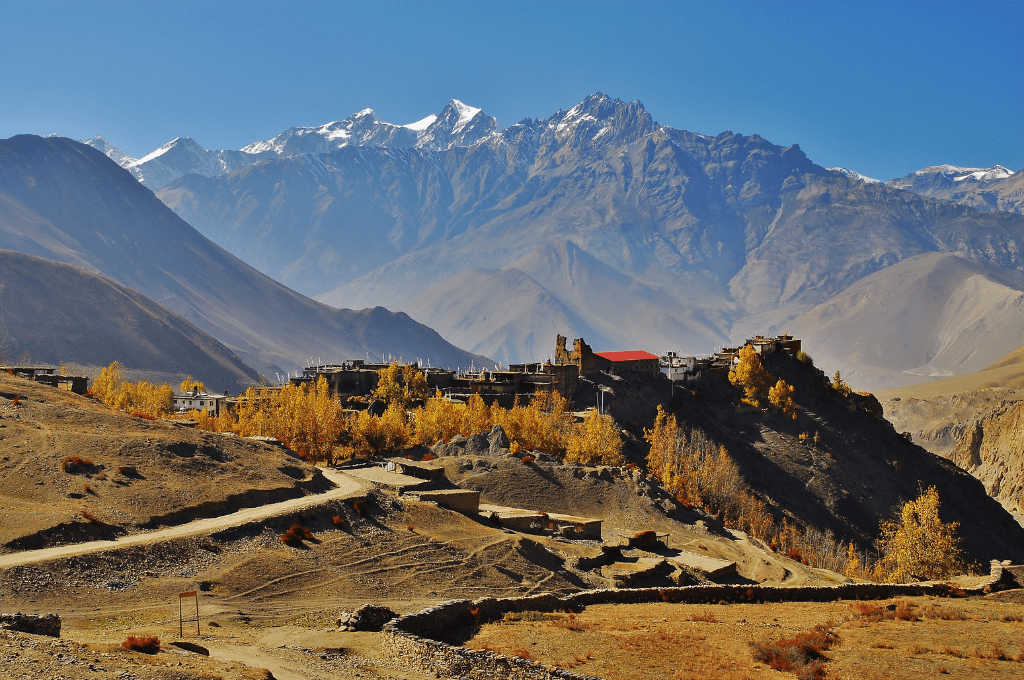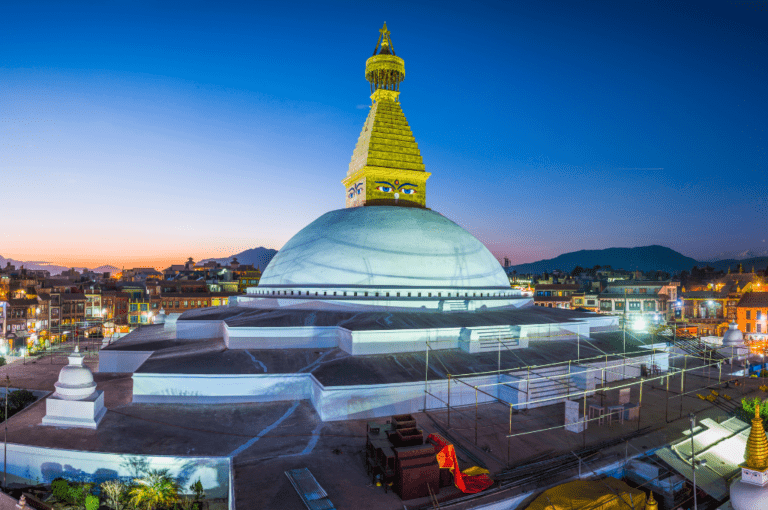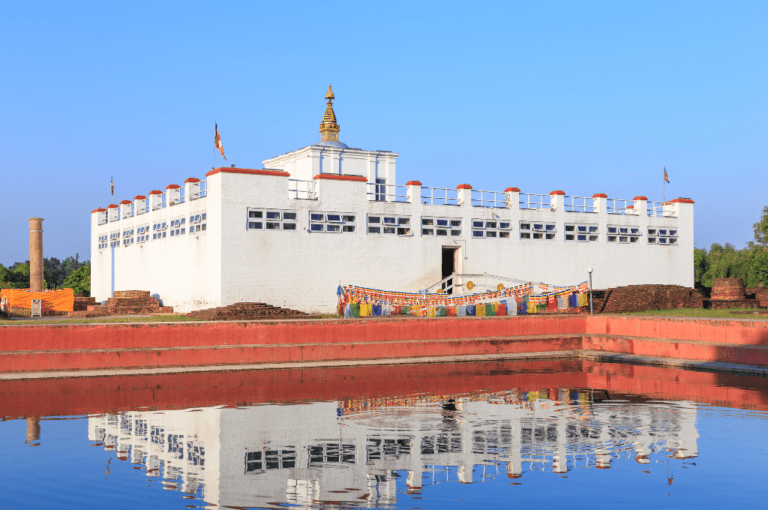Nestled in the rain shadow of the Himalayas, Mustang, often called the “Forbidden Kingdom,” is a hidden gem in Nepal that captivates both adventure explorers and culture enthusiasts. This comprehensive guide will uncover the mysteries and intricacies of Mustang, offering an exhaustive overview of its geographical, cultural, and historical aspects, and providing essential information for an enriching and well-prepared visit in 2024.
Introduction to Mustang

Mustang is a remote and enchanting region in the north-central part of Nepal, bordered by the Annapurna and Dhaulagiri mountain ranges to the south and the vast Tibetan Plateau to the north. The region is divided into two main sections: Lower Mustang, with its charming villages like Jomsom, and Upper Mustang, a mystical and once-forbidden kingdom. The landscape ranges from high-altitude deserts to lush river valleys, creating a unique and diverse environment for travellers.
Historical Context
Mustang has long captured the imaginations of adventurers and cultural enthusiasts alike. Its history is intertwined with tales of trade along the ancient Salt Route. The region was once closed to foreigners until 1992, contributing to its moniker as the “Forbidden Kingdom.” Today, travellers can explore Mustang’s unique landscapes, immerse themselves in its distinctive culture, and witness the convergence of Tibetan and Nepali traditions.
Geography and Climate
Landscape Features
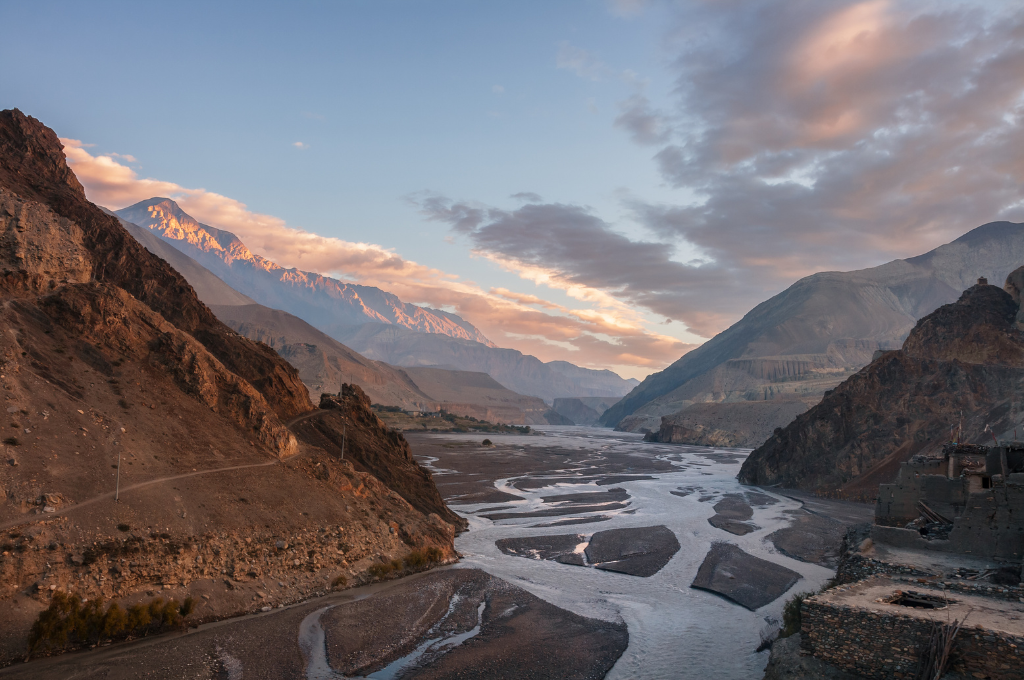
The Kali Gandaki River, flowing through the region, has carved the deepest gorge in the world, adding an extra layer of geographical intrigue to Mustang. The landscape is dotted with ancient monasteries, caves adorned with centuries-old paintings, and traditional mud-brick villages that echo the cultural influences of neighbouring Tibet. The capital of Upper Mustang, Lo Manthang, with its historic palaces and walled city, exudes an aura of mystery and heritage.
Climate Overview
Mustang, situated in the rain shadow of the Annapurna and Dhaulagiri mountain ranges, experiences a distinctive climate marked by its high altitude and arid conditions. Summers, from May to September, bring relatively warm daytime temperatures ranging from 15 to 25 °C, but nights can be cold, particularly at higher elevations. Winters, spanning November to February, are characterized by cold temperatures, with daytime highs between 5 and 15 °C and freezing nights. The region witnesses the influence of the monsoon season from June to September, with precipitation remaining comparatively low. Due to the Kali Gandaki Valley’s wind tunnel effect, strong winds are a notable feature, especially in the afternoon.
Best Time to Visit Mustang
The best seasons to visit Mustang for an ideal experience are during Spring (March to May) and Autumn (September to November). During spring, the weather is mild and pleasant, with blooming flowers adding vibrancy to the landscape. Autumn offers stable weather conditions with clear skies, making it ideal for trekking and other outdoor explorations. These seasons provide an optimal balance between favourable weather, stunning scenery, and cultural experiences, attracting trekkers and travellers keen on discovering the unique beauty of the Mustang region.
Top Attractions in Mustang
Lower Mustang
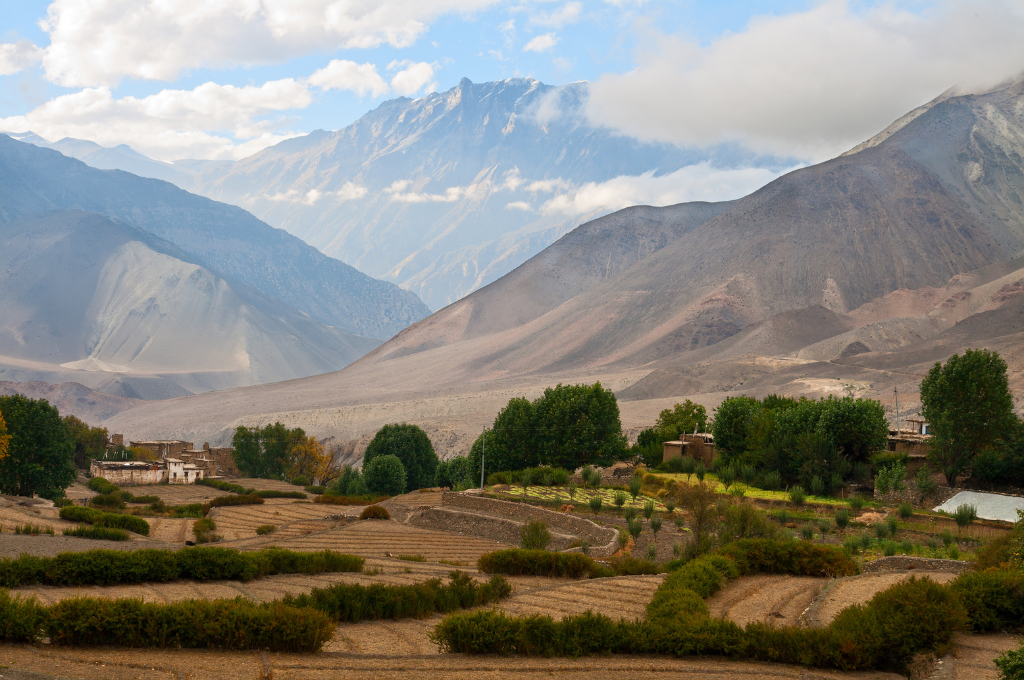
- Muktinath Temple: Undertake a sacred pilgrimage to Muktinath Temple, revered by both Hindus and Buddhists. The temple is a significant spiritual site and offers a unique cultural experience.
- Kali Gandaki Gorge: Witness the majesty of the Kali Gandaki Gorge, one of the world’s deepest, offering awe-inspiring natural views.
- Marpha Village: Explore the enchanting village of Marpha, known for its apple orchards, white-washed houses, and cobbled streets.
- Jomsom: Enjoy the serene atmosphere and take in the views of the surrounding mountains, making Jomsom a perfect resting point on your Mustang journey.
- Dhumba Lake: Experience the serene allure of Dhumba Lake, a hidden gem nestled in the Mustang region. The still water reflects the surrounding Dhaulagiri and Nilgiri mountain ranges, creating a picturesque scene.
Upper Mustang

- Lo Manthang: Wander through the captivating capital of Upper Mustang, where ancient palaces and monasteries tell tales of a rich cultural heritage.
- Thubchen Gompa and Jampa Gompa: Discover historic monasteries like Thubchen Gompa and Jampa Gompa, which offer insights into the region’s religious and cultural practices.
- Tiji Festival: Immerse yourself in the vibrant Tiji Festival in Lo Manthang, an annual celebration featuring traditional dances, rituals, and ceremonies.
- Ancient Cave Dwellings: Traverse the barren landscapes and explore ancient cave dwellings that hold centuries-old Buddhist paintings and manuscripts.
How to Get to Mustang
By Air
The most convenient way to reach Mustang is by air. There are regular flights from Pokhara to Jomsom, the gateway to Mustang. The flight offers stunning views of the Annapurna and Dhaulagiri ranges. Once in Jomsom, you can start your trek or take a jeep to your destination.
By Road
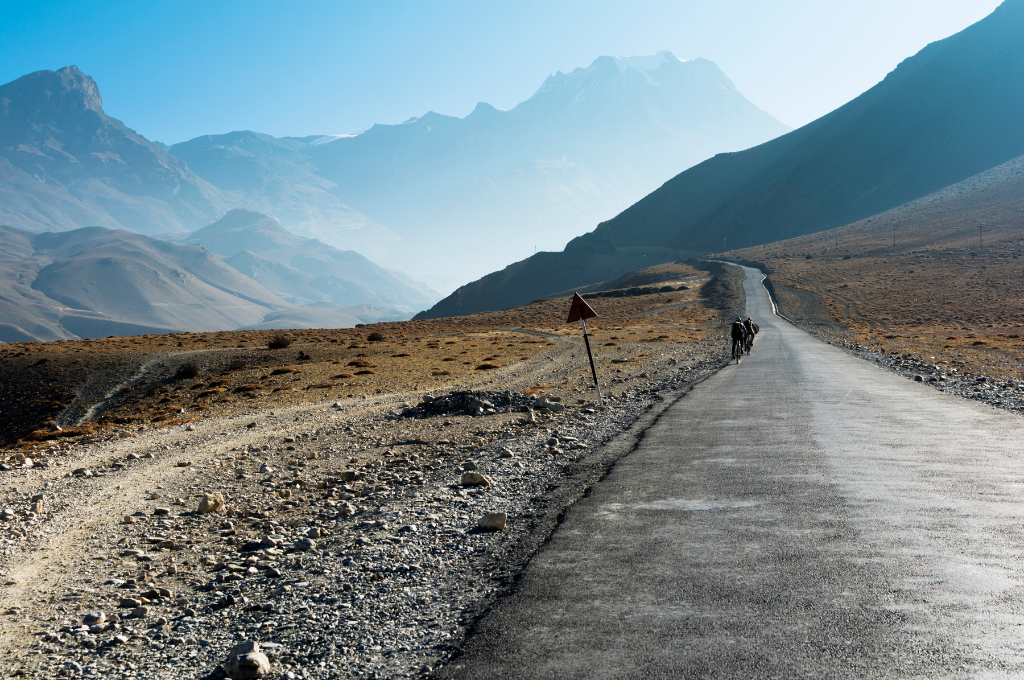
Travelling by road to Mustang is another adventurous option. You can take a bus or hire a private vehicle from Pokhara to Jomsom. The road journey, though long and bumpy, provides an opportunity to experience the diverse landscapes and local villages along the way.
Trekking Routes
For trekking enthusiasts, Mustang offers several trekking routes. The classic Annapurna Circuit passes through the Lower Mustang, while the Upper Mustang Trek takes you deeper into the restricted areas, requiring a special permit.
Permits and Regulations
Required Permits

- Annapurna Conservation Area Permit (ACAP): Mandatory for all visitors to the Mustang region.
- Trekkers Information Management System (TIMS) Card: Required for trekking in Nepal.
- Restricted Area Permit: Necessary for Upper Mustang. This can be obtained through a registered trekking agency and costs around $500 for the first 10 days, with an additional charge for extra days.
Regulations
Due to its sensitive location near the Tibetan border, Mustang has strict regulations to preserve its cultural and environmental heritage. Ensure you follow all local laws and respect the traditions and customs of the local people.
Cultural Insights
Festivals and Traditions

Mustang is rich in cultural heritage, with several festivals and traditions unique to the region. The Tiji Festival is one of the most significant, celebrating the victory of good over evil with elaborate rituals and dances performed by monks. The Yartung Festival, a horse-racing event, is another highlight, showcasing the equestrian skills of the local people.
Local Cuisine
Mustang’s cuisine reflects its Tibetan influences, with dishes like Thukpa (noodle soup), Tsampa (roasted barley flour), and Yak Cheese being staples. Don’t miss trying the local apples and apple products like cider and brandy, especially in Marpha village.
Language and Religion
The predominant language in Mustang is Tibetan, although Nepali is also widely spoken. Buddhism is the main religion, with numerous monasteries and religious sites scattered across the region. Hinduism also has a significant presence, particularly in Lower Mustang.
Accommodation Options

Teahouses and Lodges
Most trekkers in Mustang stay in teahouses or lodges, which offer basic amenities such as a bed, meals, and sometimes hot showers. These are available in most villages along the trekking routes.
Camping
For a more adventurous experience, you can opt for camping. This is especially popular in Upper Mustang, where you can set up camp in remote areas and enjoy the pristine natural surroundings.
Luxury Options
In recent years, luxury lodges have started to appear in Mustang, particularly in Jomsom and Lo Manthang. These offer more comfortable accommodations with better facilities, catering to those looking for a bit more comfort after a day of trekking.
Practical Tips for Travelers
Packing Essentials
- Clothing: Layered clothing to accommodate temperature fluctuations, sturdy trekking boots, a warm jacket, and a raincoat.
- Gear: Trekking poles, a sleeping bag, a good quality backpack, and a water purification system.
- Health: First aid kit, altitude sickness medication, and sunscreen.
Health and Safety
- Altitude Sickness: Acclimatize properly and ascend gradually to avoid altitude sickness.
- Hydration: Drink plenty of water and avoid alcohol, which can exacerbate dehydration at high altitudes.
- Food Safety: Eat only at reputable places and avoid raw or undercooked foods to prevent foodborne illnesses.
Communication and Connectivity
While Mustang is remote, many teahouses and lodges offer Wi-Fi, which can be slow and unreliable. Mobile networks are available in some areas, but it’s advisable to get a local SIM card for better connectivity.
Currency and Payments
Carry enough Nepali Rupees (NPR) as ATMs are scarce in Mustang. Most transactions are done in cash, and only a few places accept credit cards.
Responsible Travel
Environmental Conservation

Mustang is a fragile environment, and minimising your impact is crucial. Stick to marked trails, dispose of waste properly, and avoid using single-use plastics.
Cultural Respect
Respect the local customs and traditions. Always ask for permission before taking photos of people or religious sites, and dress modestly.
Supporting Local Communities
Choose locally-owned accommodations and services to help support the local economy. Buying local products and crafts also helps sustain the traditional livelihoods of the Mustang people.
Conclusion
Mustang is a unique destination that offers a blend of natural beauty, cultural richness, and historical intrigue that is unparalleled. Whether you’re trekking through its dramatic landscapes, exploring ancient monasteries, or engaging with the warm and hospitable locals, Mustang promises an unforgettable adventure. As you plan your journey to this mystical region in 2024, keep in mind the practical tips, cultural insights, and responsible travel practices outlined in this guide to ensure a fulfilling and respectful experience.
Frequently Asked Questions (FAQs)
1. What is the best time to visit Mustang?
The best time to visit Mustang is during the Spring (March to May) and Autumn (September to November) seasons. These periods offer the most stable weather conditions, clear skies, and vibrant landscapes.
2. Do I need a special permit to visit Upper Mustang?
Yes, a Restricted Area Permit (RAP) is required for Upper Mustang. This can be arranged through a registered trekking agency and costs around $500 for the first 10 days, with additional charges for extended stays.
3. What kind of accommodation is available in Mustang?
Accommodation options in Mustang range from basic teahouses and lodges to luxury lodges in certain areas like Jomsom and Lo Manthang. Camping is also an option for those seeking a more adventurous experience.
4. How do I get to Mustang?
The most common way to reach Mustang is by flying from Pokhara to Jomsom. Alternatively, you can travel by road or trekking from various points along the Annapurna Circuit.
5. Is Mustang safe for solo travellers?
Yes, Mustang is generally safe for solo travellers. However, it is recommended to join a group or hire a guide, especially when trekking in remote areas, to ensure safety and assistance in case of emergencies.
6. What should I pack for a trip to Mustang?
Pack layered clothing for varying temperatures, sturdy trekking boots, a warm jacket, rain gear, a sleeping bag, and a first aid kit. Don’t forget essentials like sunscreen, a hat, and a water purification system.
7. What kind of food can I expect in Mustang?
Mustang offers a variety of Tibetan-influenced dishes such as Thukpa (noodle soup), Tsampa (roasted barley flour), and Yak Cheese. The region is also known for its apples and apple-based products like cider and brandy.
8. Can I access the internet and mobile networks in Mustang?
While connectivity can be limited, many teahouses and lodges offer Wi-Fi, though it might be slow. Mobile networks are available in some areas, so getting a local SIM card for better connectivity is advisable.
9. How can I travel responsibly in Mustang?
Travel responsibly, stick to marked trails, dispose of waste properly, avoid single-use plastics, respect local customs and traditions, and support local businesses by choosing locally-owned accommodations and purchasing local products.
10. What health precautions should I take when travelling to Mustang?
Ensure you are properly acclimatized to prevent altitude sickness, stay hydrated, carry a first aid kit, and be cautious with food and water to avoid foodborne illnesses.
